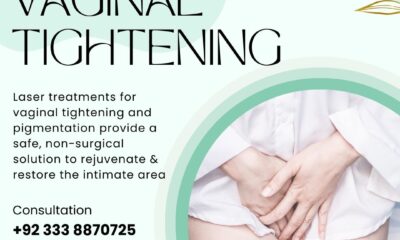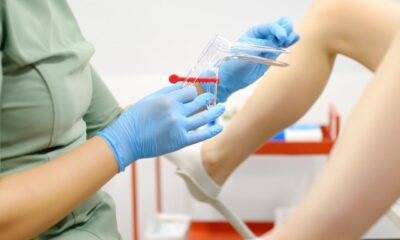Blog
Vaginal Tightening Surgery, Vaginoplasty Treatment Options

Vaginoplasty in Pakistan, Vaginal laxity, also known as vaginal looseness, can significantly impact a woman’s well-being, particularly affecting those who are sexually active. This condition may induce feelings of self-consciousness during intercourse. Leading to performance anxiety and a notable decline in confidence.
Typically, vaginal laxity results from natural occurrences like vaginal childbirth and the aging process. If you notice that vaginal laxity is negatively affecting your quality of life. Especially if accompanied by symptoms related to other pelvic floor conditions, it’s advisable to seek a consultation with a highly experienced gynecologist at Aesthedoc Clinc in Islamabad and Lahore.
Vaginal laxity often coincides with various issues such as pelvic organ prolapse and urinary incontinence. The tailored treatment approach will depend on the specifics of your individual condition. Aeshedoc doctors, a board-certified specialist in pelvic medicine and reconstructive surgery. It is highly regarded within this field. Prioritizing each patient’s unique goals and concerns when formulating treatment strategies.
This article aims to comprehensively explore the topic of vaginoplasty treatment in Pakistan. We’ve received numerous inquiries from women who lack knowledge about vaginoplasty, including its purpose and procedures. Vaginoplasty offers the possibility for women to address concerns related to the size of their internal hymen or vaginal canal.
While several clinics in Pakistan offer this treatment, patient experiences vary, with some reporting satisfaction and others encountering challenges. We’ll delve into these aspects in the following sections.
What is meant of Vaginoplasty in Pakistan?
A cosmetic surgery operation called vaginal tightening, or vaginoplasty (عورت کی شرمگاہ) , is performed using both non-surgical and surgical techniques. Women with large hymens or vaginas have this procedure to reconstruct them into their natural size and form. Women’s vaginal laxity regains its proper form with vaginoplasty surgery. This treatment is available at very reasonable cost in Islamabad, Lahore, Pakistan.
Vaginal tightening is the term used to describe a range of non-surgical and surgical procedures intended to tighten the vaginal canal or firm the skin surrounding the vagina.
By addressing issues including dry vagina, incontinence, and sexual dysfunction, this all-encompassing method enhances vaginal health and function overall.
In this post, you have to look all the important information about any kind of vaginal laxity, loseness, change in shape, form, tissue structure of vagina. For the treatment required surgical or non surgical intervention to restore its shape (into original form), integrity and tissue elasticity of vagina.
What Causes Vaginal Laxity or Why Does the Vagina Get Loose?
Vaginal laxity (VL) refers to the sensation of vaginal looseness that can occur following a vaginal birth and pregnancy. Menopause, aging, and previous pelvic surgery can all have an impact on VL. A condition known as pelvic organ prolapse (POP) causes the pelvic organs to drop out of their natural place.
1-Aging
Collagen, the most abundant protein in the body and the main component that gives your tissues stability, is lost as we age. Your vaginal tissues may gradually become more slack due to a decrease in collagen.
Some women may naturally have vaginal laxity as they age, which is caused by the vaginal muscles and tissues gradually weakening and atrophying over time.
In your 30s to 40s, you might start to notice a change in the flexibility of your vagina. This is because as you approach the perimenopausal stage, your estrogen levels will start to decline.
2-Delivery
After a vaginal birth, vaginal looseness is a frequent occurrence, particularly if you had a large kid. It results from stretching of the pelvic floor muscles during vaginal birth and the vagina, particularly the vaginal opening.
Women body will naturally alter after giving delivery. Your vaginal muscles must expand during a vaginal delivery. In order to make a space big enough for the baby to pass through the birth canal and exit your vagina.
i) Simple Vaginal Delivery (SVDS)
This happens when a woman gives birth to her child naturally, without the aid of medication or other labor-inducing methods. And without the need for forceps, vacuum extraction, or cesarean surgery. a vaginal birth that occurs naturally without the use of medication to induce labor. It’s ideal to go into natural labor at 40 weeks of pregnancy.
This is the situation that arises when a pregnant woman gives birth to her child via the vagina (birth canal) without the need for forceps, vacuum extraction, or a cesarean section. And also without the use of medications or other methods to induce labor. Approximately four million vaginal births occur in Pakistan annually, the majority of which are spontaneous. As we’ll see later, nevertheless, it should be mentioned that not all moms or pregnant women. They are recommended to have spontaneous vaginal deliveries. In 2009, 58.1% of all women giving birth in South Asia did it vaginally spontaneously.
ii) Delivery with Higher Baby Weight > 8 IBS
Delivery with higher baby weight typically refers to childbirth involving infants who weigh more than the average newborn. In medical terms, this is often referred to as macrosomia.
Macrosomia is defined as a birth weight of more than 4,000 grams (8 pounds, 13 ounces) regardless of gestational age. However, some sources may define macrosomia as a birth weight above 4,500 grams (9 pounds, 15 ounces) or even 5,000 grams (11 pounds, 0 ounces).
Delivery with a higher baby weight can present challenges during childbirth, both for the mother and the baby. Some potential complications associated with delivering a larger baby include:
- Difficulty during labor: A larger baby may have difficulty passing through the birth canal, leading to a longer or more complicated labor process.
- Increased risk of birth injuries: Both the baby and the mother are at an increased risk of birth injuries. Such as shoulder dystocia (when the baby’s shoulder gets stuck behind the mother’s pelvic bone), brachial plexus injury, and perineal tears for the mother.
- Operative delivery: In some cases, especially if labor is prolonged or complications arise, a healthcare provider may recommend an operative delivery. Such as a cesarean section (C-section), to safely deliver the baby.
- Postpartum hemorrhage: The risk of postpartum hemorrhage may be higher in deliveries with larger babies due to potential trauma during birth.
- Hypoglycemia: Larger babies are at an increased risk of hypoglycemia (low blood sugar) shortly after birth, which may require monitoring and treatment.
iii) Frequent or Constant Fluctuations Weight During Pregnancies
Pregnancy causes the average person to gain between 11.5 and 16 kg of weight. However, your pre-pregnancy weight and other factors will determine how much weight you should acquire.
You might begin by figuring out your pre-pregnancy body mass index (BMI) to determine how much weight you should acquire.
Your weight category will be indicated by your pre-pregnancy BMI:
- BMI of less than 18.5 (Underweight)
- BMI of 18.5 to 24.9 (In a healthy weight range)
- BMI of 25 to 29.9 (Overweight)
- BMI of 30 or over (Obese before your pregnancy)
What Fluctuation (20kg to 30kg) During Each Pegnancy Causing
- Extra Force
- Pressure
- Pelvic Gutter Muscles Under Gravity
3-Long or Deep Episiotomy
A surgical incision called an episiotomy is used to enlarge the vaginal opening. This makes it easier for your baby’s head to fit through. An episiotomy won’t be necessary for most people.
The midline incision, which faces back toward your anus, and the mediolateral incision. Which faces away from your anus, are the two different forms of episiotomy incisions.
First-degree: A little rip involving only the vaginal lining.
Second-degree: A rip that penetrates your vagina’s lining and reaches the vaginal tissue underneath. Second-degree episiotomies predominate.
Third-degree: A rip encompassing the tissues and lining of your vagina as well as the anal sphincter.
Fourth-degree: The anal sphincter, rectum, vaginal lining, and vaginal tissues are all impacted by the tear. The kind of tear that is the worst and causes the greatest problems.
4-Use of Ventouse/ Suction Vacuum
The baby’s head is suctioned to a ventouse, or vacuum cup. A tube connects a metal, plastic, or soft cup to a suction apparatus. The cup securely fits over your infant’s head. The obstetrician or midwife gently pulls to assist in the delivery of the baby during a contraction while you push. In cases where you are fewer than 36 weeks pregnant and require assistance giving birth. Forceps may be a better option than ventouse. This is because your baby’s head is softer at this stage of pregnancy, so there’s less chance of harm from forceps.
5-Use of Forceps
Forceps are thin, smooth metal tools that resemble big tongs or spoons. To fit around the baby’s head, they are curved. Your baby’s head is gently placed around the forceps. Which are then attached at the handles.
An obstetrician gently pulls to assist in the delivery of your baby while you push during a contraction.
Why Might Women Need Suction Vacuum or Forceps?
Assisted deliveries are utilized in approximately 1 out of every 8 births and may be necessary under various circumstances:
- If advised against pushing due to an underlying health issue like high blood pressure.
- When concerns arise regarding the baby’s heart rate.
- If the baby is positioned awkwardly.
- When the baby shows signs of fatigue or distress.
- During the vaginal delivery of a premature baby, where forceps can shield the baby’s head from the perineum.
- When an epidural is required for pain management during labor.
Typically, a pediatrician is present to assess the baby’s condition post-birth. Additionally, antibiotics may be administered intravenously to minimize the risk of infection after delivery.
6- Victim of Rape Cases
Forceful vaginal trauma in these situations can result in vaginal rips, tissue rupture, hematoma formation, and the need for vaginal repair.
In the rape cases, the rectum may be affected if the tear extends across the rectovaginal septum due to the application of very deep force. The first penetration, congenital vaginal abnormalities, intoxication of either party, violence, and insertion of foreign objects. Which are risk factors for vaginal damage during sexual activity.
Hematomas may result from localized trauma or injury. Blood can seep into the surrounding tissue when blood vessel walls are broken by an injury. Any blood vessel, including veins, arteries, and capillaries, can develop hematomas. The hematoma’s placement may alter its character. Although, this is one of other reasons for hymen repair surgery.
7-Multiple Vaginal Births
Women body will naturally alter after giving delivery. Your vaginal muscles must expand during a vaginal delivery in order to make a space big enough for the baby to pass through the birth canal and exit your vagina.
- Your vagina could feel a little bit looser than it did before giving birth. That is anticipated.
- A few days after giving birth, your vagina should begin to tighten again,
- Though it might not take its former shape entirely.
Your vaginal muscles are more likely to lose some of their flexibility if you’ve given birth via vaginal means several times.
There are activities to strengthen your vaginal floor muscles before, during, and after pregnancy if this makes you uncomfortable.
Some other reasons are available caused for vaginoplasty:
- Trauma during childbirth
- Fall in labour room
- Fall on staris during last trimester of pregnancy
- Road side accident
- Domestic violence household
Lack of Awareness about Menopuse & Peri-Monopause
Traditionally, women aren’t formally educated about menopause, and many general practitioners lack extensive training on the subject. This study aims to investigate the attitudes and knowledge regarding menopause among perimenopausal women.
In terms of women’s perspectives on menopause, nearly 39% embraced it while over 30% dreaded it. The women surveyed reported experiencing various menopausal symptoms such as mood swings (68.9%), brain fog (68.3%), and fatigue (66.8%). Surprisingly, more than 90% had never received formal education about menopause during their schooling, and over 60% felt uninformed about it. A majority, about 83.6%, believed that schools should initiate menopause education. Interestingly, when experiencing symptoms, 68.2% of women sought information about menopause, primarily through conversations with friends and various websites.
Conclusion:
Insufficient education for women and their healthcare providers is resulting in perimenopausal women navigating this significant life stage with inadequate knowledge and medical support. It’s crucial to incorporate menopause education into the curriculum starting from school, ensuring women are informed about this transition early on. Additionally, there’s a pressing need to provide comprehensive training for healthcare professionals. Beginning with the medical school curriculum, to better address the needs of menopausal women.
Lack of Exercise by Women in 30s and 40s
While some helpful exercises, such as kegel and other pelvic floor exercises, assist women in tightening the laxity and strength of the muscles surrounding the vagina. When it comes to women, the majority lack sufficient awareness about the activity and are unaware of its functions.
Engaging in pelvic exercises is an effective method to bolster the strength of your pelvic floor muscles, integral for supporting various organs, like bladder, rectum, small intestine, and uterus. As these muscles may weaken due to factors like aging or childbirth. Individuals may experience issues such as urinary or fecal leakage, frequent urination, pelvic pain, or discomfort during intercourse.
While pelvic floor exercises can mitigate mild urinary incontinence, they may not provide significant benefits for severe cases. Consulting with a healthcare professional is advisable to devise a tailored treatment plan for Vaginoplasty in Pakistan, Lahore, Islamabad and so on.
For Kegel exercises:
- Identify your pelvic floor muscles by halting urination midstream.
- Once located, follow these steps:
- Choose a comfortable position, often lying on your back.
- Contract your pelvic floor muscles and hold for 5 seconds, then relax for another 5 seconds.
- Repeat this sequence at least 5 times, gradually increasing to 10-second holds. Avoid tensing other muscle groups and focus solely on the pelvic floor.
For pelvic tilt exercises:
1. Stand with your back and shoulders against a wall, keeping knees slightly bent.
2. Draw your belly button towards your spine, flattening your back against the wall.
3. Hold this position for 4 seconds before releasing.
4. Repeat multiple times throughout the day to strengthen vaginal muscles.
Sendentary Life Style Affect on Vaginal Laxity
A sedentary lifestyle, characterized by prolonged periods of sitting or inactivity, can have a significant impact on vaginal laxity.
A healthy lifestyle can help prevent vaginal laxity by promoting pelvic floor strength and overall tissue health. Regular exercise, maintaining a healthy weight, staying hydrated, eating a balanced diet, avoiding smoking and excessive alcohol, practicing good posture, managing stress, engaging in regular sexual activity, and seeking pelvic floor physical therapy if needed, all contribute to maintaining vaginal tone and elasticity.
1-Bad Diet Pattern
A poor diet pattern characterized by the consumption of fatty foods, overeating, an increase in body mass index (BMI), and indulgence in junk foods can have detrimental effects on vaginal laxity. Let’s delve into how each of these factors influences vaginal health:
- Fatty Foods: Diets high in unhealthy fats, such as saturated and trans fats found in fried foods, processed snacks, and fatty meats, can contribute to weight gain and obesity. These fats not only add excess calories but also promote inflammation throughout the body. Including the tissues of the vagina. Chronic inflammation can lead to collagen degradation and weaken the supportive structures of the vaginal walls, contributing to laxity over time.
- Overeating and Increased BMI: Overeating, coupled with a sedentary lifestyle, often leads to weight gain and an increase in BMI. Excess weight puts additional pressure on the pelvic floor muscles, which support the organs of the pelvis, including the vagina. The increased load on these muscles can lead to weakening over time, contributing to vaginal laxity. Moreover, higher BMI levels are associated with hormonal imbalances, particularly elevated estrogen levels, which can further exacerbate vaginal tissue relaxation.
- Junk Foods: Junk foods, characterized by their high levels of sugars, refined carbohydrates, and artificial additives, offer little to no nutritional value. Consuming these foods regularly can lead to nutrient deficiencies and disrupt hormonal balance. For example, high sugar intake can spike insulin levels, leading to insulin resistance and increased androgen production. Which can disrupt estrogen levels and contribute to vaginal dryness and laxity.
2-Bad Sleep Pattern
While the direct relationship between sleep patterns and vaginal weight or laxity may not be extensively studied. There are several indirect ways in which poor sleep patterns can impact overall health, hormonal balance, and pelvic floor function. Which in turn may affect vaginal health and elasticity.
- Hormonal Imbalance: Sleep plays a crucial role in regulating hormone levels, including those that influence vaginal health. For example, inadequate sleep can disrupt the balance of hormones such as cortisol, insulin, leptin, and ghrelin, which regulate metabolism, appetite, and stress response. Disrupted hormone levels can lead to imbalances in estrogen and progesterone, which are essential for maintaining the thickness and elasticity of vaginal tissues. Estrogen, in particular, plays a significant role in keeping the vaginal walls lubricated and firm. Any disruption in estrogen levels can contribute to vaginal dryness and laxity.
- Impact on Weight Regulation: Poor sleep patterns have been linked to weight gain and obesity. Sleep deprivation can disrupt the balance of appetite-regulating hormones, leading to increased feelings of hunger and cravings for high-calorie, carbohydrate-rich foods. Chronic sleep deprivation can also impair glucose metabolism and insulin sensitivity, increasing the risk of insulin resistance and weight gain. Excess weight and obesity can exert pressure on the pelvic floor muscles, weakening their support of the pelvic organs. Including the vagina, and potentially contributing to vaginal laxity over time.
- Increased Inflammation: Sleep deprivation and poor sleep quality have been associated with increased inflammation in the body. Chronic inflammation can lead to tissue damage and breakdown, including in the vaginal walls. Inflammation can weaken the collagen and elastin fibers that provide structural support to the vaginal tissues, contributing to laxity and decreased firmness.
3-Handling Identifying Depression, Anxity & Postpartum Depression
Depression, anxiety, and postpartum depression are complex mental health conditions. These can have significant effects on various aspects of a person’s life, including their physical health and sexual well-being. For Vaginoplasty in Pakistan, Vaginal laxity, which refers to a loosening of the vaginal muscles and tissues. It can be influenced by these mental health conditions. Although the relationship is not direct and straightforward. Let’s delve into each of these conditions and explore how they might impact vaginal laxity:
- Depression and Anxiety:
- Depression and anxiety can lead to changes in hormone levels and neurotransmitter activity in the body. Chronic stress associated with these conditions can disrupt the balance of hormones like cortisol, which may indirectly affect the pelvic floor muscles.
- Persistent feelings of sadness, hopelessness, or worry can contribute to muscle tension in the pelvic floor, which may manifest as pelvic floor dysfunction, including issues with vaginal laxity.
- Additionally, depression and anxiety can affect libido and sexual arousal. Reduced sexual activity and decreased lubrication during intercourse may lead to decreased muscle tone in the vaginal area over time.
- Postpartum Depression:
- Postpartum depression (PPD) is a form of clinical depression that occurs after childbirth. Hormonal fluctuations, sleep deprivation, and the challenges of caring for a newborn can exacerbate feelings of stress and anxiety.
- During pregnancy and childbirth, the pelvic floor muscles undergo significant strain and stretching to accommodate the growing fetus and facilitate delivery. After childbirth, these muscles may be weakened or damaged, leading to issues such as vaginal laxity.
- Women with postpartum depression may be less likely to seek treatment or engage in activities that promote pelvic floor health, such as pelvic floor exercises (Kegels), which can contribute to ongoing laxity.
- Behavioral Factors:
- Individuals experiencing depression, anxiety, or postpartum depression may engage in coping mechanisms that can indirectly affect vaginal laxity. For example, some may adopt sedentary lifestyles or unhealthy dietary habits, which can contribute to weight gain and weaken pelvic floor muscles.
- Substance abuse, which is sometimes associated with these mental health conditions, can also have detrimental effects on pelvic floor health and muscle tone.
- Psychosomatic Connections:
- There may also be psychosomatic connections between mental health and physical symptoms. In other words, the mind-body connection plays a role in how mental health conditions manifest physically. For instance, chronic stress or unresolved emotional issues may manifest as physical tension in the pelvic floor, contributing to symptoms of vaginal laxity.
It’s essential to note that while depression, anxiety, and postpartum depression can indirectly impact vaginal laxity, they are not the sole determinants. Vaginal laxity can also result from natural aging, childbirth, hormonal changes, genetics, and certain medical conditions.
4-Concept of Women and Aging in Society
The concept of women and aging in society intersects with the issue of vaginal laxity in several ways. Vaginal laxity, which refers to the loosening or stretching of the vaginal muscles and tissues, is a common concern for many women as they age, and it can have significant implications for their physical health, sexual well-being, and overall quality of life. Let’s explore how societal attitudes towards aging women influence perceptions of vaginal laxity and impact women’s experiences:
- Cultural and Social Expectations:
- Societal attitudes towards aging women often place a strong emphasis on youthfulness and physical appearance. In cultures where youth and beauty are highly valued, there may be stigma or shame associated with signs of aging, including changes in vaginal tone.
- Women may feel pressure to conform to unrealistic standards of beauty and sexuality, which can lead to feelings of inadequacy or self-consciousness about their bodies as they age. This pressure may be exacerbated by media representations that portray youth as the epitome of attractiveness.
- As a result, women may be reluctant to discuss concerns about vaginal laxity or seek treatment due to fear of judgment or societal expectations regarding aging and sexuality.
- Sexualization and Objectification:
- Women’s bodies, particularly their reproductive organs, are often subject to sexualization and objectification in society. This can contribute to the perception that a woman’s worth is tied to the tightness or appearance of her vagina, leading to feelings of insecurity or shame if she perceives herself as not meeting these standards.
- Advertising, pornography, and popular culture often reinforce the idea that vaginal tightness is synonymous with youth and desirability, creating unrealistic expectations for women as they age.
- Healthcare and Medicalization:
- Despite the prevalence of vaginal laxity among aging women, discussions about this issue are often stigmatized or overlooked in healthcare settings. Women may feel uncomfortable raising concerns about vaginal laxity with their healthcare providers due to embarrassment or fear of being dismissed.
- Additionally, healthcare professionals may lack training or awareness about the physical and emotional impact of vaginal laxity on women’s health and well-being. This can result in inadequate support and treatment options for women seeking help for this issue.
- Gender Inequality and Power Dynamics:
- Gender inequality and power dynamics within intimate relationships and society at large can also influence women’s experiences of vaginal laxity. Women may feel pressure to prioritize their partner’s sexual satisfaction over their own comfort and well-being, leading them to endure pain or discomfort during intercourse.
- Lack of communication and mutual understanding between partners about sexual health and pleasure can further contribute to feelings of shame or inadequacy surrounding vaginal laxity.
- Empowerment and Self-Acceptance:
- Despite societal pressures and expectations, many women are challenging traditional norms and embracing their bodies as they age. Empowerment movements focused on body positivity, self-acceptance, and sexual autonomy encourage women to celebrate their bodies at every stage of life, including changes related to aging and childbirth.
- Open conversations about sexual health and pleasure, along with access to education and resources, empower women to advocate for their needs and seek appropriate treatment for issues like vaginal laxity without shame or judgment.
In conclusion, the concept of women and aging in society profoundly influences perceptions of vaginal laxity and shapes women’s experiences of this common concern.
5-Lack of Self Love Among Women
The lack of self-love can impact the dynamics of intimate relationships, particularly when it comes to communication and mutual satisfaction. Women who lack self-love may struggle to assert their needs and desires in relationships, prioritizing their partner’s pleasure over their own well-being.
This dynamic can contribute to feelings of resentment or dissatisfaction, as women may feel disconnected from their own bodies and desires. Vaginal laxity may exacerbate these feelings, as women may perceive themselves as inadequate or unable to fulfill their partner’s expectations.
Women who lack self-love may face barriers to seeking help for issues related to vaginal laxity. They may feel ashamed or embarrassed to discuss their concerns with healthcare providers, fearing judgment or dismissal.
Additionally, women who lack self-love may downplay their symptoms or delay seeking treatment, believing that they are unworthy of care or attention. This can lead to unnecessary suffering and exacerbation of physical and emotional symptoms related to vaginal laxity.
Vaginoplasty Procedures Information
To begin with, the practice of treating vaginal tightening has become popular all over the world. The reason is that every woman who is well-versed in this surgery is receiving care from a skilled gynecologist with complete pleasure. You must research a qualified surgeon, her background, the clinic’s location, and patient reviews before to receiving treatment.
A surgeon will consult with you to go over your symptoms and your surgical goals. Make use of this opportunity to learn about the procedure’s advantages and disadvantages and to ask questions. A doctor will advise you on the best guidelines, courses of therapy, sessions, etc.
Types of Vaginaoplasty Procedures
A) Non Surgical Method
- Radiofrequency (RF) Therapy
- Sylfirm
- Platelet-Rich Plasma (PRP) Therapy
- Vaginal Threads
- HIFU
- Fractional Laser
- Exosomes
- Vaginal Profhilo
- Vaginal Boosters
B) Surgical Method
- Perineoplasty
- Anterior and Posterior Repair
(A) Non Surgical Procedures: Vaginoplasty
Non-surgical procedures for vaginoplasty typically aim to improve vaginal tone, tightness, and overall vaginal health without the need for invasive surgery. Some common non-surgical procedures include:
i) Radiofrequency (RF) Therapy
RF therapy uses radiofrequency energy to heat the tissues of the vaginal canal, stimulating collagen production and tightening the vaginal walls. This procedure can improve vaginal laxity, urinary incontinence, and sexual satisfaction. RF therapy is often performed in a series of sessions for optimal results.
Collagen production rises during the procedure, which takes 20 minutes on average, as a result of the heat the radiofrequency device applies to the tissue.
- Heat from radiofrequency is applied to the vulva and vaginal linings.
- It causes the tissues in the vagina to tighten and shrink by restructuring the collagen and elastin,
- Enhancing blood flow,
- And increasing wetness
Complications: Undergoing treatment from a local clinic or an inexperienced surgeon who is not a gynecologist can heighten the risks associated with surgery. There’s a greater likelihood of encountering complications such as
- Damage to surrounding blood vessels and nerves
- During needle insertion, leading to excessive bleeding
- Potentially irreversible neurological damage,
- Resulting in long-term numbness and tingling.
ii) CO2 Laser Therapy
CO2 laser therapy involves the use of a carbon dioxide laser to deliver controlled thermal energy to the vaginal tissues. Similar to RF therapy, CO2 laser therapy stimulates collagen production and tightens the vaginal walls. It can also improve vaginal lubrication and reduce symptoms of vaginal atrophy.
The average time to finish the treatment is 10 to 15 minutes, although each patient’s experience may differ.
Complications: Having surgery performed by an untrained surgeon who is not a gynecologist or by a local clinic can increase the dangers involved with the procedure. Infection by bacteria, viruses, yeast, or fungi are among the complications, which can cause keloid or hypertrophic scarring.
Reactions to unusual sensitivities are not unusual. Hypopigmentation does not go away. Permanent damage to tooth enamel and ectropion are also possible.
iii) Platelet-Rich Plasma (PRP) Therapy
PRP therapy involves injecting platelet-rich plasma, derived from the patient’s own blood, into the vaginal tissues. The growth factors in PRP promote tissue regeneration, collagen production, and improved blood flow, leading to enhanced vaginal tone and sensitivity.
PRP therapy may also be combined with other non-surgical procedures for synergistic effects.This innovative form of non-surgical, 20-minute office treatment makes use of platelet-rich plasma (PRP) therapy.
- Preserve the cervix’s and vagina’s mucosal surface integrity
- Ensure a consistent menstrual cycle
- Enhance the tone of the pelvic floor muscles
- Mend the rips and cracks in the vaginal skin
PRP therapy can promote joint and trauma-related wound healing. This method can improve other cosmetic treatments, treat male pattern baldness, and encourage the growth of hair transplants.
iv) Vaginal Threads
A non-surgical technique that is becoming more and more popular to enhance the look and functionality of the vagina is vaginal thread lifting. In order to elevate and tighten the region, specific threads (Aptos Threads) are injected into the vaginal tissue.
The patient is frequently given a local anesthetic by the doctor to numb the area during a vaginal thread-lifting surgery. The threads are then inserted into the vaginal tissue using a specialist needle.
Biocompatible materials like polydioxanone (PDO), which is frequently used in medical sutures, are employed to manufacture the threads. The process takes between 30 and 60 minutes to finish, which is fairly speedy.
Because of the way they are made, threads help the tissues synthesise Elastin and Collagen Type (I) and Type (III). This allows us to minimize pigmentation on the Labia majora, relieve vaginal dryness, and reposit subcutaneous fatty tissues.
Complications: You run the danger of experiencing uncontrollable discomfort, thread extrusion, dimpling, sensory abnormalities, and foreign body reactions if you have treatment from an inexperienced physician.
V) HIFU Vaginal Tightening
High-Intensity Focused Ultrasound, or HIFU for short, is a focused ultrasound treatment that targets different depths of the body’s tissue to tighten, lift, and contour the skin.
The painless process takes up to 30 minutes per session, requires no recovery time from the patient, and is completely non-surgical.
The short and non-invasive technique has minimal downtime and yields results nearly instantly. It increases collagen regeneration and fresh collagen formation at the source.
- Elevated moisture levels in the vagina
- Clinically validated – secure and efficient
- Not a moment of silence
- After just one treatment, results are visible, and they may persist for up to two years
- Strengthened, taut, and firmer muscles in the area that was treated
- Lowering or getting rid of bacterial infections in the vagina
Complications: Potential side effects that may arise from receiving therapy from a less qualified physician include
- excruciating pain,
- infections,
- fibrosis,
- tissue remodeling and destruction,
- discomfort, and
- dyspareunia
Vi) Vaginal Profhilo
Vaginal Profhilo is a non-surgical procedure that involves the injection of hyaluronic acid (HA) into the vaginal tissues. Hyaluronic acid is a naturally occurring substance found in the body, known for its ability to hydrate and plump the skin. During the procedure, a small needle is used to inject HA into specific areas of the vaginal wall.
Mechanism of Action: The injected hyaluronic acid helps to hydrate and rejuvenate the vaginal tissues, promoting increased elasticity and firmness. It also stimulates collagen production, which further enhances tissue integrity and resilience. As a result, vaginal Profilo can help improve vaginal tightness, reduce dryness, and enhance sexual satisfaction.
- Non-surgical and minimally invasive.
- No downtime or recovery period.
- Improves vaginal tightness and tone.
- Enhances vaginal lubrication and moisture.
- Can improve sexual function and satisfaction
Vii) Exosomes
Exosome therapy involves the use of exosomes, which are small vesicles derived from stem cells. These exosomes contain growth factors, cytokines, and other signaling molecules that can promote tissue regeneration and repair. In the context of vaginal tightening, exosomes are typically injected into the vaginal tissues.
Mechanism of Action: Exosomes exert their effects by delivering bioactive molecules to target cells, stimulating cellular repair and regeneration. When injected into the vaginal tissues, exosomes can enhance collagen production, improve blood flow, and promote tissue remodeling. This leads to increased vaginal tightness and tone over time.
- Stimulates natural tissue regeneration and repair.
- Improves vaginal tightness and tone.
- Enhances lubrication and moisture in the vaginal canal.
- Can improve sexual function and satisfaction.
- May have long-lasting effects with repeated treatments.
Typical Side Effect Reactions to Non-Surgical Vaginoplasty Techniques
- Pain and Discomfort: Pain and discomfort are common in the immediate postoperative period. Pain management strategies, including medication, are typically provided to alleviate this discomfort.
- Swelling and Bruising: Swelling and bruising around the surgical site are common after vaginoplasty. This usually resolves over time as the body heals.
- Infection: There is a risk of infection associated with any surgical procedure. Patients are typically prescribed antibiotics to reduce the risk of infection, and proper wound care is essential to minimize this risk.
- Bleeding: Some bleeding from the surgical site is normal immediately after surgery, but excessive bleeding may require medical attention.
- Scarring: Like any surgery, vaginoplasty can result in scarring, although surgeons aim to minimize visible scarring. Scarring can vary depending on surgical technique and individual healing factors.
How To Resolve Vaginal Laxity Issues By Surgical Procedres?
A surgical technique called a vaginoplasty is used to tighten the vaginal muscles. Vaginoplasty has a high rate of patient satisfaction, making surgery a great choice for women who are done having children.
B) Surgical Methods: Vaginoplasty
This tightening can address issues such as vaginal laxity, which may occur due to childbirth, aging, or genetics. During a vaginoplasty procedure, the surgeon typically removes excess vaginal lining and tightens the surrounding muscles and tissues. The procedure may involve:
i) Perineoplasty
This procedure focuses on the perineum, the area between the vaginal opening and the anus. Perineoplasty involves repairing and tightening the muscles and tissues in this area to improve support and enhance vaginal tone.
ii) Anterior and Posterior Repair
These procedures address specific areas of weakness or prolapse in the front (anterior) or back (posterior) vaginal wall. Anterior repair targets the bladder and urethra, while posterior repair addresses rectal prolapse or bulging.
What Operation Theatre Needs:
- Pre-anesthesia fitness
- All blood tests, CBC, Urine R/E, Thyroid, LFTTS, RFTS, PT, APTT,
- Blood Group, CRP, HBA1C,
- Lipid Profile
We must screen 1.0 blood and cross-reference math. In the event that blood is urgently needed during surgery. Anesthesia specialists do pre-anesthesia fitness exams to determine whether a patient is suitable for both general anesthesia and surgery.
- 3 day hospital after day of surgery
- Stiches will be done post surgery 2 months
- No intercource after surgery
- No heavy weight lifting
- Home bed rest recommended
A professional trained gynecologist is need, such a skilled surgeon will perform this long surgery very well. Post-operative care is mandatory to follow.
Risk Factors
These risks factors are minimal required during hospital operation theater where blood, ICU, Lab all services are available. In such a clinic there are very less chance to see the risks and side effect. In case of any complication, you can have access to any kind of specialist and operative facilities.
Infection possibility
Haemorrhage possibility
Repair delayed SPC devarged HBA 1C
Complications of Vaginoplasty During Surgical Methods
An significant consideration is the level of risk associated with surgical vaginoplasty for women. when you have surgery performed under local anesthetic at a nearby facility. Also, despite having at least 15 years of experience, your surgeon is not the greatest gynecologist. Unfortunately, there is thus a higher probability of major dangers such vaginal prolapse, urinary retention, suture line dehiscence, bleeding, infection, and skin or clitoral necrosis. Usually present from the beginning are fistulas from the bladder, urethra, or rectum.
What Are Benefits of Vaginoplasty Treatment?
Vaginal surgery, particularly when addressing issues such as vaginal fistula and urinary problems, can offer numerous benefits for women’s health and well-being. Vaginal fistula is an abnormal connection between the vagina and another organ, such as the bladder or rectum, which can lead to urinary or fecal incontinence. Urinary problems, including stress urinary incontinence (SUI) or overactive bladder (OAB), can cause discomfort, embarrassment, and disruptions to daily life. Here are some benefits of vaginal surgery in addressing these issues:
Repair of Vaginal Fistula:
- Vaginal surgery can repair vaginal fistulas, restoring the normal anatomical structure and function of the vaginal canal and adjacent organs.
- By closing the abnormal connection between the vagina and the urinary tract or rectum, vaginal surgery can eliminate symptoms such as urinary or fecal incontinence and vaginal discharge.
Resolution of Urinary Incontinence:
- For women experiencing urinary incontinence, particularly stress urinary incontinence (SUI), vaginal surgery can provide effective treatment by strengthening the pelvic floor muscles and supporting the urethra.
- By tightening the tissues surrounding the urethra and bladder neck, vaginal surgery can reduce or eliminate episodes of urinary leakage associated with activities such as coughing, sneezing, or physical exertion.
Improved Bladder Control:
- Vaginal surgery can improve bladder control and reduce symptoms of overactive bladder (OAB), including urinary urgency, frequency, and nocturia.
- By addressing underlying issues such as pelvic floor weakness or bladder dysfunction, vaginal surgery can restore normal bladder function and reduce the need for frequent trips to the bathroom.
Enhanced Quality of Life:
- Addressing vaginal fistula and urinary problems through surgery can significantly improve a woman’s quality of life by alleviating physical discomfort, emotional distress, and social embarrassment associated with these conditions.
- Improved bladder control and continence can restore confidence and independence, allowing women to engage in daily activities, social interactions, and intimate relationships without fear of leakage or accidents.
Prevention of Complications:
- Untreated vaginal fistulas and urinary problems can lead to complications such as urinary tract infections (UTIs), skin irritation, and kidney damage.
- Vaginal surgery can prevent these complications by repairing the underlying issue and restoring normal urinary and bowel function, reducing the risk of infection, inflammation, and long-term damage to the urinary tract and surrounding tissues.
Customized Treatment Approach:
- Vaginal surgery offers a customized treatment approach tailored to the individual needs and preferences of each patient.
- Surgeons can adapt surgical techniques to address specific concerns, such as the size and location of the fistula, the severity of urinary symptoms, and any concurrent pelvic floor issues, ensuring optimal outcomes and patient satisfaction.
Minimally Invasive Options:
- Many vaginal surgeries for fistula repair and urinary problems can be performed using minimally invasive techniques, such as laparoscopy or robotic-assisted surgery.
- Minimally invasive approaches offer benefits such as smaller incisions, reduced pain and scarring, shorter hospital stays, and faster recovery times compared to traditional open surgery.
Long-lasting Results:
- Vaginal surgery for fistula repair and urinary problems can provide long-lasting results, with many women experiencing significant improvement or resolution of symptoms following surgery.
- By addressing the underlying cause of the issue and restoring normal anatomy and function, vaginal surgery can offer lasting relief from urinary incontinence, overactive bladder, and vaginal fistulas.
Improved Sexual Function:
- For women experiencing sexual dysfunction or discomfort related to vaginal fistula or urinary problems, vaginal surgery can improve sexual function and satisfaction.
- By resolving physical symptoms such as pain, leakage, or vaginal discharge, vaginal surgery can enhance intimacy and sexual well-being, allowing women to enjoy a fulfilling and satisfying sex life.
Comprehensive Care and Support:
- Vaginal surgery for fistula repair and urinary problems typically involves a multidisciplinary approach, with collaboration between gynecologists, urologists, and other healthcare providers.
- Patients receive comprehensive pre-operative evaluation, surgical intervention, and post-operative care, along with education and support to optimize recovery and long-term outcomes.
How To Avoid Constipation After Gynecological Surgery
Constipation frequently occurs following gynecological surgery and can become severe enough to necessitate hospital readmission for pain management and to rule out complications. Factors contributing to post-operative constipation include anesthesia, narcotic pain medication, reduced physical activity, and certain anti-nausea drugs.
Individuals with pre-existing constipation are particularly vulnerable, as surgical or medicinal interventions may exacerbate their condition. Therefore, special attention must be paid to monitoring and managing constipation in these patients to prevent worsening symptoms and potential complications.
Maintain Proper Hydration:
Ensure adequate fluid intake to keep stools soft and facilitate passage. In addition to water, consume beverages like tea, coffee, and fruit juices containing electrolytes. However, excessive consumption of pure water without electrolytes should be avoided to prevent rare but serious conditions like water poisoning and brain edema. Aim for approximately 8 cups of fluid per day.
Include Fiber-rich Foods:
Incorporate fiber-rich foods into your diet to promote bowel regularity. There are two types of fiber: insoluble and soluble. While insoluble fiber aids bowel activity, soluble fiber may exacerbate constipation by absorbing water from the bowels, leading to further obstruction.
Stay Active:
Engage in light exercises such as walking to stimulate bowel movements and prevent constipation. Find a balance between being active and resting during the early phases of post-surgical recovery. Gradually increase activity levels while allowing for adequate rest periods.
Consider Stool Softeners:
Stool softeners available over-the-counter can help soften stool and ease passage. Purchase stool softeners from pharmacies without needing a prescription for added convenience.
Try Enemas:
If constipation persists, consider using small enemas to release impacted stool. Enemas can help alleviate discomfort caused by long-standing constipation by clearing obstructions.
Listen to Your Body:
Pay attention to your body’s signals and respond promptly to the urge to have a bowel movement. Delaying bowel movements may exacerbate constipation and discomfort.
Be Aware: For Patient
As a client, looking for vaginal tightening procedures, it is a very private and taboo topic. Selection of doctor for any kind of vaginal procedures is the most important aspect. You should look for a female gynecolologist with at least 15 years of experience in the field of gynecology. This procedure can not be performed by a general MBBS/ Dermatologist or Aesthetician. Nonetheless, a gynecologist should be chosen who has extensive training in pelvic gutter surgery, tissue dissection, and the comprehensive orientation of female anatomy during childbirth and after childbirth.
FAQs about Vaginoplasty
What is vaginoplasty?
A vaginal reconstruction is a surgical operation used to restore a vagina that has been damaged by disease, trauma, or other circumstances.
What symptoms do women who get vaginal rejuvenation typically experience?
Vaginal opening, tampons falling out, bowel movement problems, reduced friction and sensation during sex, sense of a wider, looser, and smoother vagina, and gas noises during intercourse are some of the factors that lead women to have vaginoplasty surgery.
Does rejuvenating the vagina produce better orgasms?
Naturally, the vaginal rejuvenation process enhances orgasm since it increases friction during sex and addresses vaginal looseness. Women will have more sexual pleasure once the vagina is tightened, which leads to bigger orgasms and the best kind of enjoyment.
How soon after vaginal rejuvenation can You have sex?
According to an expert gynecologist, you should give yourself at least six weeks to recuperate fully before engaging in sexual activity again because your body needs that time. Since the purpose of vaginoplasty is to have enjoyable sex, make sure you follow your plastic surgeon’s instructions and post-operative instructions.
What is the duration of vaginal rejuvenation?
Female genital plastic surgery, sometimes referred to as vaginal rejuvenation surgery, is usually an outpatient, low-risk, safe treatment that takes one to two hours.
Conclusion
In conclusion, vaginal canal surgical procedures, including vaginoplasty and reconstructive surgery, are performed to address a range of issues affecting the vaginal canal, from aesthetic concerns to medical conditions. These procedures aim to improve vaginal tone, function, and overall quality of life for patients. As with any surgical intervention, it’s important for patients to discuss their goals, expectations, and concerns with a qualified healthcare provider before undergoing vaginal surgery.
Contact with Exceptionally Skilled Gynecologist
Aesthedoc is one of Pakistan’s leading gynecologists at the moment. Thanks to her extensive experience and the large number of patients that visit the clinic in Islamabad at address F7, she is performing a fantastic job.
Blog
O‑Shot + Laser Combo for Vaginal Rejuvenation

If you’re looking for a powerful, synergistic approach to intimate wellness, the O‑Shot + Laser combo at Aesthedoc Clinic in Rawalpindi is one of the most advanced, evidence-based treatments available today. This combination therapy leverages the regenerative power of Platelet-Rich Plasma (PRP or “O‑Shot”) with the collagen-stimulating and tightening effects of fractional laser therapy, offering deeper rejuvenation, improved sensation, and enhanced vaginal health.
Under the skilled care of Dr. Naila Frukh, a fellowship-trained cosmetic gynecologist, we deliver this treatment in a safe, confidential, and medically guided environment.
This guide explains:
- What exactly the O‑Shot is
- How combining PRP with laser creates a superior effect
- Key benefits of the combo
- Treatment process & what to expect
- Safety, research evidence & risks
- Ideal candidates for the combo
- Cost guide for Rawalpindi
- Why Aesthedoc Clinic is the right place for this
- How to book your consultation
What Is the O‑Shot (PRP for Vaginal Health)?
The O‑Shot refers to the injection of Platelet-Rich Plasma (PRP) into specific areas of the female genital tract — often the vaginal wall, clitoral region, or labia. PRP is derived from your own blood and is rich in growth factors, cytokines, and other signaling molecules that can:
- Promote tissue regeneration
- Stimulate collagen and elastin production
- Enhance blood vessel formation (angiogenesis)
- Improve moisture and lubrication
These effects can help in boosting sexual sensitivity, improving lubrication, and supporting tissue health.
Why Combine O‑Shot (PRP) with Laser Therapy?
Using PRP together with fractional laser therapy produces a synergistic effect:
- Enhanced Tissue Remodeling
- The laser creates micro-injuries (microthermal zones) in the vaginal tissue, which initiates a healing process.
- PRP amplifies this repair response by delivering concentrated growth factors to these micro-injured areas.
- Clinical research shows that combining PRP with fractional laser enhances collagen production, skin elasticity, and tissue regeneration.
- Faster Healing and Reduced Downtime
- Studies indicate that when PRP is added to laser treatment, recovery (e.g., erythema and crusting) is faster than with laser alone.
- PRP may reduce inflammation and stimulate repair, helping skin heal more comfortably and quickly.
- Improved Clinical Outcomes
- In urogynaecological settings, combining PRP with fractional CO₂ laser has shown better functional outcomes (such as reduced urinary incontinence) than laser alone.
- For vaginal mesh–related issues, combined therapy helped many women avoid further surgery while improving sexual and bladder function.
- Synergistic benefits of PRP + laser have also been reported in aesthetic (skin) studies.
- Longer-Lasting Effect
- The combined regenerative effect often leads to more durable improvement, because tissue is remodeled more deeply and robustly.
Therefore, the O‑Shot + Laser combo is widely recognized in aesthetic gynecology for its ability to provide both rejuvenation and functional enhancement in vaginal tissues.
Key Benefits of the O‑Shot + Laser Combo at Aesthedoc Clinic
- Improved Vaginal Tightness & Elasticity: The laser tightens the tissues; PRP reinforces strength.
- Enhanced Sensation & Libido: PRP helps restore blood flow and neural growth, while laser improves tissue structure.
- Reduced Vaginal Dryness: Regenerated tissue secretes more natural lubrication.
- Better Urinary Support: In some studies, this combo improves mild stress urinary incontinence.
- Safe & Minimally Invasive: No major surgery or long recovery; most people tolerate it very well.
- Long-Term Skin Health: Ongoing collagen remodeling helps maintain results.
- Synergistic & Efficient: A single treatment plan addresses multiple issues (tightness, moisture, sensitivity) in one go.
Treatment Process: What to Expect at Aesthedoc Clinic
1. Initial Consultation
- Assessment: Dr. Naila Frukh evaluates your vaginal health, skin condition, and sexual/function goals.
- Medical History: Review of your health, any bleeding disorders, hormone status, and previous gynecological history.
- Customized Plan: Based on your assessment, a tailored protocol is designed (number of sessions, intensity of laser, PRP dose).
2. Pre-Treatment Preparation
- Blood draw for PRP (usually 10–20 mL).
- PRP preparation in a sterile centrifuge.
- Cleansing the treatment area.
- Application of topical anesthetic to ensure comfort.
3. Laser Application
- Use of a fractional laser (e.g., CO₂) to deliver microthermal injury into the vaginal or vulvar tissue.
- Laser settings are customized based on tissue condition and patient comfort.
4. PRP Injection or Application
- PRP is either injected into the vaginal wall, labia, or clitoral region, or applied topically to micro‑injured areas.
- The growth factors begin their work immediately, stimulating cell regeneration and collagen growth.
5. Post-Treatment Care
- Mild vaginal discomfort or a warm sensation may occur for a short period.
- Recommended rest for the day and avoid sexual activity or tampon use for a brief period (as advised).
- Gentle vaginal hygiene; avoid harsh soaps or products.
6. Follow-Up Sessions
- Typically, 2–4 sessions spaced 4–6 weeks apart are recommended for optimal results (this depends on individual needs).
- Maintenance plan: periodic “top-up” PRP or mild laser, depending on how your tissues respond.
Safety, Research Evidence & Considerations
Research & Clinical Evidence
- Stress Urinary Incontinence: A clinical trial showed that women receiving both PRP and fractional CO₂ laser had greater improvements than those receiving either treatment alone.
- Gynecologic Mesh Complications: Combined PRP + CO₂ laser helped many women avoid further surgery while improving symptoms.
- Skin Rejuvenation: Older studies show that PRP + fractional laser improves collagen, elasticity, and patient satisfaction.
- Safety Profile: PRP is generally well tolerated, with minimal side effects in gynecologic use.
Safety Considerations
- There is no large-scale randomized trial specifically for “O‑Shot + laser for vaginal tightening” in all populations — results are promising but relatively new.
- Patients should be well informed about realistic expectations.
- Laser and regenerative treatments must be done by experienced professionals (like Dr. Naila Frukh) to minimize risks like burns, pigmentation changes, or infection.
- Aftercare and follow-up are key to achieving safe and effective results.
Who Is an Ideal Candidate for This Combo?
- Women who want stronger treatment than PRP alone for vaginal rejuvenation
- Those experiencing vaginal laxity + low sensitivity
- Women with mild stress urinary incontinence looking for non-surgical options
- Patients who want to avoid or postpone more invasive surgeries
Not ideal candidates might include:
- Individuals with untreated infections or active genital lesions
- Those on blood-thinning medications (unless cleared)
- Patients unable to commit to follow-up sessions
- Women who are pregnant or breastfeeding (treatment may be postponed)
Expected Results & Timeline
| Timeline | What to Expect |
|---|---|
| Immediately After Session | Mild warmth or tingling; slight swelling may occur |
| Weeks 1–2 | Collagen remodeling begins; feel initial tightening and improved lubrication |
| Months 2–4 | Best improvements in vaginal tone, sensitivity, and overall tissue quality |
| Months 6+ | Maintenance may be needed; many women report durable results with periodic touch-ups |
Cost Estimate for O‑Shot + Laser Combo in Rawalpindi
These are approximate estimates. Actual pricing depends on number of sessions, device used, and bespoke treatment plan.
- PRP (O‑Shot) per session: PKR ~ 30,000 – 60,000
- Fractional Laser per session: PKR ~ 25,000 – 70,000
- Combo Package (PRP + Laser): Often more cost-effective when purchased as a plan — approximate range PKR 50,000 – 120,000 per “combo” session, depending on the clinic and protocols.
Why Choose Aesthedoc Clinic for O‑Shot + Laser Treatment
- Expert Surgeon: Dr. Naila Frukh is a specialist in aesthetic gynecology with advanced training, ensuring safe, precise, and effective treatment.
- Medical-Grade Facilities: We use certified laser devices and sterile PRP preparation protocols.
- Customized Plans: Treatment is tailored to your anatomy, concerns, and healing potential.
- Patient Safety & Comfort: We prioritize high-quality care, minimal discomfort, and clear aftercare.
- Follow-Up & Maintenance: We provide post-treatment monitoring and maintenance protocols to help you preserve results.
How to Book Your O‑Shot + Laser Consultation
- Contact Aesthedoc Clinic in Rawalpindi via phone/WhatsApp or their website.
- Book a detailed consultation with Dr. Naila Frukh.
- She will assess your vaginal tissue, talk through options, and create a personalized treatment plan.
- You’ll receive a clear cost estimate, number of sessions, and pre- & post‑treatment instructions.
- Begin your rejuvenation journey safely and confidently.
Frequently Asked Questions (FAQ)
Q1: Is this painful?
A: Discomfort is minimal. We use topical numbing or local anesthesia as needed, and most patients tolerate the treatment well.
Q2: Do I need multiple sessions?
A: Yes. Typically 2–4 “combo” sessions are used to achieve strong, sustained results.
Q3: How long do the effects last?
A: Many women enjoy benefits for 12–18 months or more; maintenance sessions help prolong results.
Q4: Is there a risk of scarring or burns?
A: When performed by a skilled gynecologist-laser specialist, the risk is low. Proper settings and post-care minimize complications.
Q5: Can men use a similar combo?
A: While “O‑Shot” is typically used in female anatomy, PRP + laser regenerative concepts are used in other areas — but this specific combo is designed for vaginal tissue.
Blog
Scar Revision After Delivery or Surgery in Rawalpindi

Scars are part of healing — but for many people, they remain a constant reminder of surgery, childbirth, or injury. Whether it’s a cesarean‑section scar, a stretch mark–type scar after delivery, or scarring from any surgery, these marks may cause physical discomfort or emotional distress. The good news: with modern aesthetic‑gynecology and dermatologic techniques, scar revision is safer, more effective, and more accessible than ever in Rawalpindi.
At Aesthedoc Clinic, under the expert care of Dr. Naila Frukh, we offer a comprehensive suite of scar‑revision treatments tailored to your specific scar type, skin tone, and medical history. Our goal is not just to fade or flatten scars — but to help you feel more confident in your own skin.
1. Why Scar Revision Matters
- Emotional impact: Scars remind us of difficult times — pregnancy, childbirth, surgery. Many of our patients say that revising these scars helps their self-esteem and sense of normalcy again.
- Physical discomfort: Scar tissue can be tight, raised, or tethered, limiting movement or causing itching, pulling, or irritation.
- Skin quality: Old scars may be discolored, thick, or irregular. Revising them can restore smoother, more elastic skin that more closely matches the surrounding tissue.
- Preventive opportunity: With early scar‑revision techniques (especially lasers), you can reduce the long-term visibility of fresh surgical scars. Research shows that fractional CO₂ laser applied early (even before suture removal) can improve scar appearance.
2. Types of Scars You Can Treat at Aesthedoc Clinic
At Aesthedoc Clinic, we tailor treatments to the type and age of the scar. The most common post‑delivery or post‑surgical scars include:
- Linear surgical scars (e.g., C-section, laparotomy)
- Hypertrophic scars (raised but not beyond the wound boundaries)
- Atrophic (depressed) scars (scar tissue is thin or sunken)
- Stretch mark–type scars (from skin stretching)
- Tethered scars (scar attached to underlying tissue, restricting movement)
3. Evidence-Based Scar Revision Treatments
We base our treatment plans on established, evidence-backed modalities:
A. Microneedling (Percutaneous Collagen Induction)
- What it is: Very fine needles create controlled micro-injuries in the scar, triggering the body’s natural healing response and collagen production.
- Clinical evidence: In a study of 25 postoperative patients, microneedling significantly improved scar texture and pliability, measured by validated scar scales.
- Long-term outcomes: A large follow-up study of 120 patients (facial and non-facial scars) showed 50–75% improvement after an average of 2.5 microneedling sessions.
- Recovery: Mild redness, minimal downtime; safe for a broad range of skin types.
B. Platelet-Rich Plasma (PRP) Therapy
- What it is: PRP is derived from your own blood. It’s rich in growth factors that help regenerate tissue, soften scar texture, and improve scar color.
- Evidence: A study of 107 patients treated with microneedling + PRP reported improved scar pliability, color, and mobility.
- Meta-analyses: Research suggests PRP improves wound healing and early scar quality.
- Benefits: Reduced inflammation, accelerated healing, and enhanced cosmetic outcome when combined with microneedling or laser.
C. Fractional Laser Therapy
- What it is: Fractional CO₂ or Er:YAG lasers create microthermal zones in the skin, remodeling scar tissue while preserving surrounding skin.
- Early intervention: Some data suggest that early fractional CO₂ treatment (even before suture removal) can reduce scar formation in Asians.
- Combination with PRP: When PRP is added to non-ablative laser therapy, several studies show improved texture, color, and faster healing.
- Risks: As with any laser, risk of pigmentation changes must be managed carefully — especially in darker skin types.
D. Silicone Gel Sheeting
- What it is: Medical-grade silicone sheets or gels applied to scars to hydrate and flatten them.
- Clinical support: Silicone sheeting remains a first-line scar‑management therapy and is widely endorsed in scar‑care literature.
- Advantages: Non‑invasive, low-risk, and effective for hypertrophic or raised scars if used consistently.
E. Advanced Combinations
Depending on scar type, we often recommend a multi-modal approach:
- Microneedling + PRP
- Laser + PRP
- Laser + silicone sheeting
- RF‑assisted microneedling (especially useful for thicker or tethered scars)
This hybrid strategy typically produces superior results compared to a single modality.
4. The Aesthedoc Clinic Scar Revision Process
Step 1: Initial Consultation
- Dr. Naila Frukh assesses your scar: location, age, thickness, pigmentation, and skin type
- Review of your medical history, wound-healing profile, and aesthetic goals
- Discussion of realistic outcome expectations
Step 2: Customized Treatment Plan
- Based on the scar assessment, we recommend the most suitable modality or combination
- We explain the number of sessions, expected downtime, and costs
- Pre-treatment care instructions are provided (e.g., sun protection, avoiding certain creams)
Step 3: Treatment Sessions
- For microneedling/PRP: We draw your blood, prepare PRP, and combine with skin needling
- For laser: We apply topical numbing, then treat the scar with a fractional laser device
- For silicone therapy: We guide you on application and duration for optimal effect
Step 4: Aftercare & Maintenance
- Gentle care instructions: avoid friction, keep the area clean, use scar-care ointments
- Follow-up visits to assess improvement and decide on further sessions
- Maintenance plan: PRP or silicone sheeting or periodic laser as needed
5. Recovery & What to Expect
| Phase | Typical Healing & Results |
|---|---|
| Day 0–3 | Redness, swelling, possible mild tenderness; take care to avoid friction. |
| Week 1 | Skin begins to remodel; topical care and hydration important. |
| Weeks 4–8 | Collagen remodeling peaks; scar texture improves visibly. |
| After All Sessions | Final results typically seen within 3–6 months, depending on treatment plan. |
Note: Scar healing is gradual — patience and consistent aftercare are essential.
6. Potential Risks and Safety
While scar revision is generally safe, it is important to be aware of possible risks:
- Temporary redness, swelling, or sensitivity
- Pigmentary changes (especially on darker skin)
- Infection (rare, but good hygiene is critical)
- Over- or under-treatment if not done by a qualified professional
- Discomfort during treatment, managed with numbing
At Aesthedoc Clinic, all procedures are performed under sterile conditions by trained specialists, minimizing risks and optimizing outcomes.
7. Cost of Scar Revision in Rawalpindi (Estimate)
Here is a rough cost breakdown for scar‑revision services offered at or similar to Aesthedoc Clinic (2025). Final pricing will depend on scar type, size, number of sessions, and combination of treatments.
| Treatment | Estimated Cost (PKR) |
|---|---|
| Microneedling per session | 10,000 – 25,000 |
| PRP combined with microneedling | 30,000 – 60,000 (per session) |
| Fractional Laser per session | 25,000 – 70,000 |
| Silicone Gel / Sheeting (multi-month) | 5,000 – 15,000 total |
Tip: Ask about package plans for combination treatment — they often reduce per-session costs and yield better value.
8. Is This Right for You? Ideal Candidates & Contraindications
Good Candidates:
- Women (or men) with visible post-delivery or surgical scars
- People committed to multiple treatment sessions and good aftercare
- Those with realistic expectations: improvement, not total erasure
Contraindications (or need for caution):
- Active infection or inflammation in scar area
- Conditions impairing healing (e.g., uncontrolled diabetes)
- Keloid-prone individuals (some scars may require special management)
- Recent tanning or high sun exposure
Dr. Naila Frukh will perform a thorough evaluation to ensure treatment safety and appropriateness.
9. Why Choose Aesthedoc Clinic for Scar Revision
- Specialist Expertise: Dr. Naila Frukh is a fellowship-trained cosmetic gynecologist with deep experience in scar revision and skin rejuvenation.
- Comprehensive Approach: We don’t just treat the surface — we address texture, color, and depth, using multi-modal strategies.
- Personalized Care: Unlike generic aesthetic centers, we tailor treatments to your scar’s nature, skin type, and healing capacity.
- Safety First: Sterile, medical-grade devices and sterile PRP preparations.
- Ongoing Support: Follow-up visits, maintenance planning, and patient education make sure your scar continues to improve.
10. Frequently Asked Questions (FAQ)
Q: Can old scars (several years old) be improved?
A: Yes. Even mature scars respond well to treatments like microneedling, PRP, or fractional lasers. While they may not disappear completely, they can become softer, flatter, and less visible.
Q: How many sessions will I need?
A: It depends on scar type, size, and depth. Many patients benefit from 3–5 sessions of laser or microneedling + PRP, but we will tailor a plan for you.
Q: Does it hurt?
A: We use topical numbing for microneedling and lasers, so discomfort is minimal. Recovery involves mild redness and sensitivity.
Q: Will the treatment leave pigmentation or darker scars?
A: There is a risk, especially with darker skin tones, but careful device settings and aftercare reduce it. PRP and silicone therapy may help stabilize healing.
Q: Can scar revision be combined with other aesthetic treatments?
A: Absolutely. Laser scar revision can be combined with vaginal rejuvenation, tightening, or pigmentation treatments — all under the same consultation.
11. How to Book Your Scar Revision Consultation in Rawalpindi
- Contact Aesthedoc Clinic via phone or WhatsApp to schedule a consultation.
- During your visit, Dr. Naila Frukh will examine your scar, discuss goals, and propose a personalized plan.
- Receive a transparent quote, including number of sessions, expected downtime, and cost.
- Begin your treatment schedule, with follow-ups and aftercare support to maximize safety and success.
12. Final Thoughts
Scars from childbirth or surgery are common — but you don’t have to live with them forever. Through advanced treatments like microneedling, PRP, fractional laser therapy, and silicone sheeting, Aesthedoc Clinic in Rawalpindi gives you the opportunity to soften, smooth, and significantly improve the appearance of your scar tissue.
With Dr. Naila Frukh’s experienced, compassionate care and our tailored, evidence‑based approach, scar revision is not just cosmetic—it’s a step toward reclaiming your body and confidence.
Blog
Groin Stretch Mark Removal in Rawalpindi

Stretch marks — or striae — are common, and not just on the belly or thighs. Many women and men also develop stretch marks around the groin area, including the pubic mound, inner thighs, and lower abdomen. Hormonal changes, rapid weight fluctuations, pregnancy, or skin tension can all cause stretch marks in this sensitive region.
At Aesthedoc Clinic, we understand that groin stretch marks can be a source of discomfort, self-consciousness, or even embarrassment. Under the expert care of Dr. Naila Frukh, a fellowship-trained cosmetic gynecologist, we provide safe, effective, and personalized treatments designed to reduce the appearance of stretch marks while protecting the delicate skin in the groin.
In this guide, you will learn:
- What causes stretch marks around the groin
- Why the groin region is uniquely challenging
- Treatment options available at Aesthedoc Clinic
- What to expect: process, recovery, and results
- Safety, risks & candidacy
- Cost estimates in Rawalpindi
- Why you should choose Aesthedoc Clinic
- How to book a consultation
1. What Causes Groin Stretch Marks (Striae)
Hormonal & Physiological Factors
- Rapid growth or weight changes: Sudden gain in body mass (e.g., pregnancy, bodybuilding) stretches the skin.
- Hormonal fluctuations: Cortisol, estrogen, and growth hormone influence skin elasticity. High levels can weaken collagen.
- Genetics: Family history of stretch marks predisposes individuals to develop them.
- Skin tension: Skin in the groin / inner thigh region is subject to stretching with movement, leading to microtears in the dermis.
- Pregnancy: As the lower abdomen and pubic area expand, skin stretches significantly.
Mechanical Factors
- Friction: Thighs rubbing while walking, tight underwear, or exercise can aggravate skin stretch.
- Rapid muscle gain: In men or women doing strength training, rapid hypertrophy of thigh muscles may stretch overlying skin.
2. Why Groin Stretch Marks Are Special & More Challenging
- Delicate skin: The groin area has thinner, more sensitive skin than, say, the belly.
- Pigmentation risk: Treatments here carry a higher risk of post-inflammatory hyperpigmentation.
- Moisture and friction: Sweat, movement, and friction make healing more complex.
- Visibility issues: Even small stretch marks are more visible in intimate regions, so patients often want more precise, gentle, and safe treatments.
3. Treatment Options for Groin Stretch Marks at Aesthedoc Clinic
At Aesthedoc Clinic in Rawalpindi, we offer a tailored suite of treatments to minimize or remove stretch marks in the groin. Depending on stretch mark age (new/red or old/silver), skin type, and severity, we recommend one or a combination of the following:
A. Fractional Laser Therapy
- How it works: A fractional ablative or non-ablative laser (e.g., fractional CO₂ or Er:YAG) creates micro-injury columns in the skin, stimulating collagen and elastin regeneration.
- Why it’s effective: It improves skin texture, reduces thickness of stretch marks, and encourages remodeling of dermal structures.
- Sessions: Typically 3–5 sessions, spaced 4–6 weeks apart.
- Recovery: Mild redness, some peeling, subsides in a week or two.
B. Microneedling / Dermaroller
- How it works: Fine needles create controlled micro‑injuries, triggering a wound‑healing response and collagen production.
- Why it’s good for groin: Particularly suitable for stretch marks that are moderate in depth; minimal downtime; safer on pigmented or delicate skin.
- Sessions: Usually 3–6 procedures, spaced 4–8 weeks apart.
- Recovery: Mild swelling or redness for 1–2 days; avoid friction during healing.
C. Platelet-Rich Plasma (PRP) Therapy
- How it helps: Injections of PRP enhance skin regeneration, collagen remodeling, and elasticity. When combined with microneedling or laser, PRP accelerates healing and improves results.
- Procedure: Blood is drawn, centrifuged, and PRP is injected or applied on micro-needled skin.
- Recovery: Minimal; safe for sensitive areas like the groin.
D. Radiofrequency (RF) Skin Tightening
- How it works: RF energy heats the dermis, stimulates collagen contraction, and tightens the skin.
- Why choose it: Useful for mild stretch marks + sagging or lax skin in the groin / pubic region.
- Sessions: Typically 4–6, spaced a few weeks apart.
- Side effects: Mild heat sensation, slight redness.
E. Topical Treatments / Medical Peels
- Prescription peels: Superficial chemical peels (e.g., glycolic acid, TCA, or Jessner’s) enhance exfoliation and stimulate dermal repair.
- Retinoids: Under careful medical supervision, retinoid creams may help improve stretch mark appearance by promoting skin cell turnover.
- Moisturizers + Barrier Repair: Use of specialized emollients, barrier-repair creams, and silicones can support skin healing post-treatment.
F. Combination Protocols
The best results often come from combining treatments. For example:
- Microneedling + PRP: Improves collagen synthesis, speeds healing, excellent synergy.
- Laser + PRP: For more advanced or older stretch marks, this combination yields deeper remodeling and more visible improvement.
- RF + Topical: For mild stretch marks and loose skin, this reduces downtime and supports gradual skin revitalization.
4. What to Expect: Treatment Process, Recovery & Results
Pre‑Treatment Consultation
- Detailed skin assessment by Dr. Naila Frukh
- Discussion of stretch mark severity, duration, skin sensitivity
- Medical history, including any on bleeding or healing issues
- Treatment plan tailored to your skin, schedule, and comfort
During the Procedure
- Cleanse and numb the area (topical anesthesia if needed)
- Apply chosen modality (laser, microneedling, RF, PRP)
- Duration: 20–45 minutes depending on treatment
Post‑Treatment Care
- Clean the area gently, pat dry
- Apply soothing ointment as advised by the doctor
- Avoid friction, tight clothes, sexual activity for a few days (depending on procedure)
- Use sunscreen on the area if exposed (yes, groin skin needs protection during healing)
Healing & Results Timeline
| Phase | What to Expect |
|---|---|
| Days 1–3 | Redness, mild swelling, micro‑injury healing begins |
| Week 1 | Peeling (for laser/peel), light scabbing, sensitivity reduces |
| Weeks 2–4 | New collagen formation starts; skin texture improves |
| Months 2–4 | Most visible improvement in stretch mark thickness and color |
| After Procedures Complete | Gradual smoothing, flattening, and improved skin elasticity |
Maintenance sessions (e.g., yearly) may be recommended to sustain results, depending on your skin and lifestyle.
5. Risks & Safety Considerations
Groin area stretch mark removal must be handled with care. Risks are minimal when treated by qualified professionals but include:
- Temporary redness, swelling, or tenderness
- Pigmentation changes (hyper- or hypopigmentation), especially on darker or sensitive skin
- Infection (rare if aftercare is followed properly)
- Prolonged healing if friction or moisture is not managed
- Discomfort during treatment, if not numbed effectively
To minimize risks:
- Always choose a certified cosmetic doctor / gynecologist like Dr. Naila Frukh
- Follow post-treatment instructions carefully
- Wear loose, breathable clothing during recovery
- Avoid sun exposure or friction in the treated area until fully healed
6. Price Range for Groin Stretch Mark Removal in Rawalpindi
Here is a rough cost estimate (2025) for different modalities at Aesthedoc Clinic or similar clinics in Rawalpindi. Final pricing depends on how many sessions are needed, device, and area.
| Treatment | Estimated Cost (PKR) |
|---|---|
| Fractional Laser (per session) | 25,000 – 60,000 |
| Microneedling (per session) | 10,000 – 25,000 |
| PRP Therapy (per session) | 30,000 – 60,000 |
| Radiofrequency (per session) | 20,000 – 45,000 |
| Chemical Peel (groin‑suitable) | 8,000 – 20,000 |
Package deals may be available for combination therapies (e.g., microneedling + PRP, laser + PRP), and Aesthedoc Clinic often tailors a plan with cost transparency during consultation.
7. Who Is a Good Candidate — and Who Should Avoid
Ideal Candidates:
- Adults (women or men) with visible stretch marks in the groin or pubic region
- People with realistic expectations of results (improvement, not complete erasure)
- Those willing to commit to multiple sessions and adhere to aftercare
- Patients with healthy skin, no active infections, and good healing capacity
Not Ideal / Need Caution:
- Pregnant or breastfeeding individuals
- Those with uncontrolled diabetes, bleeding disorders, or impaired healing
- Active skin infections, rashes, or dermatitis in the treatment area
- People unwilling or unable to follow post-treatment care
8. Why Choose Aesthedoc Clinic in Rawalpindi
- Expertise: Under Dr. Naila Frukh, who has strong credentials in both clinical gynecology and aesthetic gynecology
- State-of-the-Art Technology: Certified fractional lasers, microneedling devices, RF machines, and PRP systems
- Holistic & Personalized Plans: We do not apply a one-size-fits-all; treatment plans are customized to your skin type, stretch mark severity, and comfort level
- Safety & Hygiene: Aesthedoc Clinic maintains the highest standards of sterilization and patient care
- Patient Education & Support: Complete pre- and post-treatment guidance, follow-up appointments, and maintenance plans
9. About Dr. Naila Frukh
Dr. Naila Frukh is a leading cosmetic gynecologist based in Rawalpindi and is associated with Aesthedoc Clinic. Her qualifications:
- MBBS – Nishtar Hospital
- WMO – Population Welfare Department
- FCPS in Obstetrics & Gynecology
- Fellowship in Aesthetic Gynecology (American Board)
Her expertise spans vaginal rejuvenation, labiaplasty, groin aesthetic treatments, PRP therapy, and more. Patients trust her for her scientific precision, compassionate care, and artistic approach to intimate-area treatments.
10. Frequently Asked Questions (FAQ)
Q1: Will my groin stretch marks disappear completely?
A: No treatment can guarantee 100% removal. However, laser, microneedling, and PRP can significantly reduce their appearance, texture, and color.
Q2: How many sessions will I need?
A: It depends on your skin, stretch mark severity, and the chosen treatment. Many patients need 3–5 sessions of laser or microneedling.
Q3: Does treatment hurt?
A: We use topical anesthesia or numbing creams. You may feel warmth, mild pricking, or tingling, but discomfort is generally minimal.
Q4: When can I resume normal activities?
A: Light everyday activities are typically okay within a day or two. Avoid friction, tight clothing, and sexual activity for a few days depending on the procedure.
Q5: Can people of all skin tones undergo this?
A: Yes, but specific lasers or microneedling settings may be tailored for darker or more pigmented skin to reduce risk of pigment changes.
Q6: Is the treatment safe for both men and women?
A: Yes. While stretch marks in the groin are commonly evaluated in women, men with similar concerns can also benefit from these treatments.
11. How to Book Your Consultation
If you are bothered by stretch marks around your groin and want to explore professional, safe, and effective removal options, Aesthedoc Clinic is your ideal partner.
To Book:
- Call or WhatsApp Aesthedoc Clinic to schedule a detailed consultation.
- During your visit, Dr. Naila Frukh will evaluate your skin, listen to your concerns, and propose a tailored plan.
- You’ll receive a transparent cost estimate, expected number of sessions, and pre‑treatment guidance.
- After treatment, you’ll also get a customized aftercare and maintenance plan.
12. Final Thoughts
Groin stretch marks are a very treatable issue thanks to modern aesthetic gynecology. With the right approach — whether laser, microneedling, PRP, or a combination — you can significantly improve the appearance and texture of your skin, build confidence, and enjoy smoother, rejuvenated results in a safe, professional setting.
At Aesthedoc Clinic in Rawalpindi, Dr. Naila Frukh and her team combine medical expertise, advanced technology, and a gentle, patient-centered approach to give you the best outcomes.
-

 Vaginal Tightening2 years ago
Vaginal Tightening2 years agoVaginal Tightening HIFU Treatment
-

 Hymen Reconstruction Surgery2 years ago
Hymen Reconstruction Surgery2 years agoCandidates For Hymen Repair, Symptoms, Causes, Treatment & Cost
-

 Hymenoplasty2 years ago
Hymenoplasty2 years agoHymenoplasty Surgical Repair in Pakistan
-

 Hymen Reconstruction Surgery2 years ago
Hymen Reconstruction Surgery2 years agoHymenoplasty Surgery in UAE, Dubai’s Expertise in Hymenoplasty
-

 Hymenoplasty2 years ago
Hymenoplasty2 years agoHymenoplasty in Rawalpindi, Hymen Repair Surgery
-

 Vaginal Rejuvenation2 years ago
Vaginal Rejuvenation2 years agoVaginal Rejuvenation Non Surgical, Rawalpindi & Lahore
-

 Hymen Reconstruction Surgery2 years ago
Hymen Reconstruction Surgery2 years agoHymenoplasty Surgeon in Rawalpindi, Hymen Repair Aesthedoc Clinic
-

 Labiaplasty2 years ago
Labiaplasty2 years agoExpert Labiaplasty Surgery in Turkey, Labiaplasty Cost in Turkey














